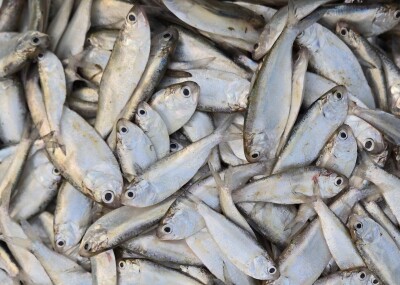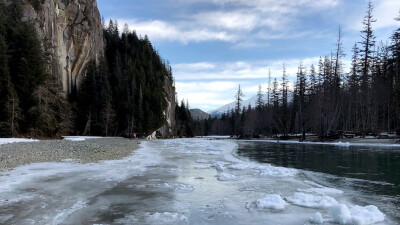All for one
Participants at the annual Seafood Summit
continue
to cultivate sustainability and consensus
By Jerry Fraser
There’s a riddle known to fishermen along the coast of Maine that goes like this:
What are the two things a guy needs if he wants to go fishing?
A pickup truck and wife who works.
About four years ago, however, Rob Seitz, a commercial fisherman in Astoria, Ore., decided he wanted something else: his own boat.
Gary Bauer (red jacket) leads Seafood Summit attendees through Pontchartrain Blue Crab, his Slidell, La., processing facility. Devin Harvey photo.Seitz had begun his career fishing halibut and salmon with his grandfather in Alaska and 25 years later was fishing groundfish and Dungeness crabs off the West Coast. But he’d been a hired captain long enough and wanted to be an owner-operator. Prospects didn’t seem all that bright in Astoria.
“I’d been in the fishery a little over 20 years trying to get ownership, and none of the people on the boats I was running wanted to sell… the IFQ system was coming.”
Fortunately for Seitz, the stars were coming into alignment. Back in 2006, with rockfish stocks down, the Nature Conservancy had bought several boats and permits along California’s Central Coast, south of San Francisco. Among the acquisitions were four trawlers from Morro Bay.
 The conservancy developed a harvest model to put the quotas it had accumulated back to work in a way that would allow recovery of the fish and protect essential habitat, with the help of 3.8 million acres of no-trawl zones. And now the conservancy had turned over $2 million in fishing rights to the Morro Bay Community Quota Fund. Enter Seitz.
The conservancy developed a harvest model to put the quotas it had accumulated back to work in a way that would allow recovery of the fish and protect essential habitat, with the help of 3.8 million acres of no-trawl zones. And now the conservancy had turned over $2 million in fishing rights to the Morro Bay Community Quota Fund. Enter Seitz.
Morro Bay was “interested in a trawler working down there,” he said. “I met someone who knew somebody, and that’s where the talks began.”
When the talks ended, Morro Bay had its man, Seitz had his boat, and the Central Coast had a new source of sustainably harvested, trawl-caught groundfish.
Stories like this, in which industry, government and NGOs come together to promote the harvest of seafood may be rarer than we’d like, but they are inspirational at assemblies such as the Seafood Summit held in New Orleans in February.
Produced by SeaWeb since 2002, the globe-trotting summit this year brought together more than 500 academics, scientists and conservationists, as well as representatives from government, industry and the media, and bills itself as “the world’s premier conference on seafood sustainability.”
As many as 30 countries were represented in New Orleans, and there was broad consensus that real-world collaboration of the sort achieved in Morro Bay had taken root at the summit. Dawn Martin, president of SeaWeb, said she observed an emphasis on solving problems, “rather just talking about them and/or pointing fingers.”
“The discussions really emphasized the need to make sure that we had the right people in the room to advance key issues,” she said. The “right people,” for example, will prove pivotal in the battle against illegal, unregulated and unreported fishing and seafood fraud, an ascendant component of the sustainable seafood movement.
To that end, Highliner Foods, the National Fisheries Institute and representatives of the Presidential Task Force on IUU fishing and Seafood Fraud have waded into the effort, helping, Martin said, to advance “agreement on key data elements for traceability.”
In 2013, Diversified Communications, the parent of National Fisherman and SeafoodSource.com and the producer of the Seafood Expo brand trade events in Boston, Europe and Asia, entered into a partnership with SeaWeb to produce the Seafood Summit on an annual basis.
Mary Larkin, an executive vice president with Diversified, called the conference a “perfect match” for the company because it provides a discussion forum for all stakeholders in the industry. “Over the years the focus on sustainability has increased among the seafood companies who participate in our events, so the extension with the Seafood Summit just made sense,” she said.
Given Diversified’s long involvement with seafood “from boat to throat,” as one DC executive likes to say, the partnership should be viewed favorably by seafood producers.
“Historically,” Martin said, “we have had good representation from the seafood supply chain, but there is always room for growth.”
Martin believes the summit derives its traction from its recognition that people connect with what they eat.
“In the earliest days,” she said, “the concept of sustainability was just beginning to take hold and our efforts were aimed at shifting the focus away from wildlife protection campaigns for fisheries to efforts aimed at making the ‘ocean-to-plate’ connection.”
A result of this was SeaWeb’s “Give Swordfish a Break” campaign, which began in 1998 and enlisted support from 700 chefs.
And while the campaign was not well received by industry, its subtext — here are all these chefs who want to serve seafood — left the door open for eventual collaboration.
“Once that focus was established,” Martin said, “we intentionally directed our efforts on integrating the other seafood stakeholders into the summit.”
Fifteen years after the swordfish campaign ended, this year’s summit made the case that collaboration is an idea whose time has come.
If the fisherman of today remains an icon signifying independence, commercial fishermen are scarcely the only piece that has been missing from the collaboration puzzle.
“We’ve done a good job of marginalizing one another,” said the president of the Global Aquaculture Alliance, Wally Stevens, whose interests have included wild fisheries as well as fish farms.
Aquaculture was a summit theme and figured prominently in the remarks of NOAA Administrator Kathryn Sullivan, the opening speaker. Although NOAA is known for overseeing marine fisheries, last year it released plans that provide for 20 fish farms in the Gulf of Mexico over the next 10 years.
“Aquaculture is a bright spot and one we need to nurture,” she said.
Most proponents of U.S. aquaculture don’t feel any more nurtured than do their seagoing counterparts in the wild-capture business. They spend much of their time on the defensive because of concerns about disease, escape, pollution and other issues and often suffer by comparison with wild-harvest seafood such as salmon.
Perhaps as a result, upward of 60 percent of global aquaculture production takes place in China — a taint in and of itself, given China’s reputation for indifference toward the environment. Yet far less farmed fish is consumed in developing countries.“There are lots of unsustainable practices around the world,” said Michael Rubino, director of NOAA’s Office of Aquaculture, who on the other hand noted the “huge evolution” of salmon farming in Maine.
Indeed, Maine has emerged, in Rubino’s words, as a “poster state for marine aquaculture,” largely as a result of support from the governor, the Legislature and the University of Maine system.
Rubino, Sullivan and others share a vision of aquaculture gaining a foothold in coastal communities across the United States, sustainably easing the economic transition from declining commercial fisheries. “Many of us think that there is a paradigm change coming,” he said.
No doubt. Fishing communities and the independent fishermen who comprise them are being overtaken by rationalization, catch restrictions and market forces.
Almost inevitably, sustainability is the tip of the spear. “After a certain point,” says Morro Bay’s Seitz, “you have to quit fighting it and [say], ‘I gotta figure how to make this thing work for me, because it’s not going away.’”
Without question, SeaWeb was prescient in enlisting chefs in the sustainability movement.
Barton Seaver, a chef and restaurateur who heads the Healthy and Sustainable Food Program at the Harvard School of Public Health, participated in three summit sessions and considers himself a seafood “evangelist” and champion of local seafood.
Ned Bell, executive chef at the Four Seasons Hotel in Vancouver, British Columbia, says chefs have the power to sow sustainability. Bell believes in a “farm to table” menu, and on the seafood side, his hotel was the first in Canada to adhere to the recommendations of Ocean Wise, a conservation effort of the Vancouver Aquarium.
“We became 100 percent sustainable,” he said. “Your business might grow substantially by choosing sustainable seafood.
“And [your customers] go to the grocery store and ask for sustainable seafood.”
If collaboration is taking hold on the water, it’s also an ascendant regime at the summit.
“The tone of the conversation has changed in recent years,” Carrie Brownstein, seafood quality standards coordinator with Whole Foods Market, said in a session wrapping up the summit. “There was much more cooperation in these sessions.”
Martin noted that New Orleans was the 11th summit. “I think this reflects the maturing of the movement,” she said.”
Andrew Jackson, a panelist on forage fishing, said he could not imagine a position of less esteem than representative of the farmed salmon industry, which he had been at early summits, until he became technical director of the International Fishmeal and Fish Oil Organization. “I found it!” he wryly observed.
And yet, this year, Jackson received one of SeaWeb’s five Seafood Champion awards, in the leadership category, for his work promoting sustainable seafood.
“We are moving much more to a consensus of what the problems are,” he said. “I’m delighted to say peace is breaking out all over the place.”
Jerry Fraser is the publisher of National Fisherman.








